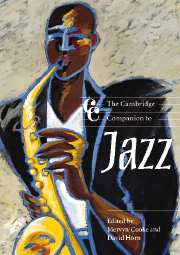Book contents
- Frontmatter
- The word jazz
- Part One Jazz times
- Part Two Jazz practices
- 5 Jazz as musical practice
- 6 Jazz as cultural practice
- 7 Jazz improvisation
- 8 Spontaneity and organisation
- 9 Jazz among the classics, and the case of Duke Ellington
- Part Three Jazz changes
- Part Four Jazz soundings
- Part Five Jazz takes
- Notes
- Works cited
- Principal musicians cited
- Index
5 - Jazz as musical practice
from Part Two - Jazz practices
Published online by Cambridge University Press: 28 September 2011
- Frontmatter
- The word jazz
- Part One Jazz times
- Part Two Jazz practices
- 5 Jazz as musical practice
- 6 Jazz as cultural practice
- 7 Jazz improvisation
- 8 Spontaneity and organisation
- 9 Jazz among the classics, and the case of Duke Ellington
- Part Three Jazz changes
- Part Four Jazz soundings
- Part Five Jazz takes
- Notes
- Works cited
- Principal musicians cited
- Index
Summary
Definitions of jazz as musical practice are contingent upon a host of factors, not least of which are the intellectual histories and life experiences that condition writers' approaches to definition. Some are likely to see as most distinctive jazz musicians' usage of rhythm, harmony, melody and/or timbre in jazz performance and composition, others the relative balance of oral/aural and textual materials, and still others the music's connections to African-American expressive culture. Early writers on jazz, for example, tended to have European concert music as their primary frame of reference. The ‘work-’ and ‘score-centric’ concepts and terminology of concert music almost dictated that these writers would focus on parameters of music making amenable to staff notation and textual analysis – e.g., melody, harmony, form (and, to a lesser degree, rhythm) – and describe jazz chiefly through the ways in which it differed from concert music. Whether or not one agrees with that approach, it is a manifestation of the desire to identify and describe jazz's distinctive character. In a world of diverse musical expressions displaced geographically and temporally, the practical necessity of making distinctions (Lakoff 1987, 5–6) has required those writing about jazz to find ways to distinguish it not only from concert music but also from Tin Pan Alley popular song, from other forms of African-American music and from other musics that prominently feature improvisation. This chapter will examine the ways in which other writers have defined jazz, taking account of the characteristics they have invoked and the usefulness of those items for definition.
- Type
- Chapter
- Information
- The Cambridge Companion to Jazz , pp. 81 - 95Publisher: Cambridge University PressPrint publication year: 2003
- 2
- Cited by



